Config23 Themes & 6 Questions to Leverage Design to its Fullest
Integrating design into organizations can be difficult, but companies that do this successfully streamline processes, innovate faster, and more readily adapt to changes. This was seen repeatedly at Figma's annual design conference, Config23. Topics included AI, leading change, and designing meetings like you design products.
The design landscape is rapidly changing, and it is important to take a look at how design can be used intentionally. Config was Figma-focused (no surprise there!), but many of its themes were team- and industry-agnostic.
But this isn’t an overview of what Figma released (although it’s worth checking out) or summaries of the talks. ChatGPT can summarize those for you. Instead, I’m diving into how UX can impact business processes and ways to leverage design strategies deeply into organizations.
6 Questions to Ask to Improve Your Design Maturity
Seer’s UX design team asks ourselves and our clients a series of questions to ensure we harness design to its fullest potential and to gauge an organization’s design maturity. We saw many of these same themes and questions throughout Config23.
1. Do you integrate design with your business goals?
“A lack of value can cheapen the perception of design” - Steve Johnson, Netflix, Design without Business is Decoration
Companies that recognize and harness the power of design as a strategic tool gain a distinct competitive advantage. Design is not confined to aesthetics; it has evolved into a strategic driver that can directly impact revenue, customer satisfaction, and innovation within an organization. Recent surveys show that nearly 3 out of 4 shoppers will abandon a brand after just one subpar experience.
Alternatively, designers need to understand business goals. Designing without this knowledge can risk prioritizing the wrong experiences, sending users down a journey that organizations aren’t set up for doesn’t help businesses or users. As a result, the customer experience will become disconnected from the service, and businesses won’t be able to measure impacts.
Aligning UX processes to goals and KPIs can improve outcomes and show value. Design is an essential link between businesses and their users, enabling companies to reach their users and fulfill their goals.
A few ways to know if design & business are aligned:
- Discussions are focused on solving problems, and engineering or implementation constraints come later.
- Design workshops and ideation sessions include team members across departments and levels.
- Qualitative data is analyzed alongside quantitative data.
- There is design representation in executive-level discussions and decision-making.

2. Do you speak a shared language?
“Words hold power. Speaking the same language irons out potential points of miscommunication.” - Som Liengtiraphan, Salesforce, From monologues to dialogues—unlocking designer-developer collaboration
A shared language is critical at every level of the organization. Shared language is how you speak about your work, users, and goals. At design conferences, naming conventions focus on improving communication between designers and developers. At Seer, we speak with our clients by understanding their language, respecting their brand voice, and focusing on their goals. Sharing language can help reduce misunderstandings and improve efficiency.
One of the best ways to create a shared language is in your user journeys and design system. A design system represents the patterns and components that build your experiences. Thoughtful naming can set organizations up to scale (see Question #4 for more on scaling), but an agreed-upon name matters most.
A few signs you have a shared vocabulary:
- All team members understand internal jargon and acronyms.
- Cross-functional teams refer to patterns in the same way.
- Development and design match and have smooth handoffs.
- Priorities tie back to transparent goals and missions.
3. Do you make room for innovation?
“We create our best work in spaces where we have fun creating.” - Jon Kaplan, Figma, Prototyping: past, present, and future
“You can tell how healthy a culture is by its investment and support in creativity.” - Kim Baschet, Stripe, Pushing design forward: from speculative methodologies to crafting delight
Without innovation, organizations can become stagnant and primed for disruption. And innovation requires space, time, and fun.
Creative ideas aren’t always easy to develop, and are even harder to implement. They take hard work, and aren’t just pulled out of thin air. They come from having a set of intentional processes and spaces that are set up to encourage innovation. Including innovation will make space for big moves that solve complex problems, like balancing two very different user groups.
I love UX because technology is an amazing gift, but it can also be one of the most frustrating parts of your day. My goal as a UX Designer is to eliminate that frustration and educate other stakeholders on usability considerations. But design also inspires. And delight in UX is important. When we don’t have the space for innovation, we also don’t have the space to incorporate delight and fun. Remember that one bad experience can make ~74% of users drop a brand? Well, 76% of customers are also ready to recommend a brand after one positive experience.
The stakes are high, and competition continues to grow. Setting up an ecosystem that fosters innovation lets teams tackle complex problems and make positive experiences.
A few ways to make space for innovation:
- Provide time and frameworks for people to explore their passions.
- Raise visibility of what teams are working on.
- Find sponsors on other teams to champion processes and features.
- Add fun to standing meetings and workflows.
More ways to encourage creativity.
4. Are your systems and processes set up to scale?
“AI can help us explore bigger patterns - freeing us up to consider the core flows of our experiences” - Noah Levin, Figma, AI and the future of Design: Designing with AI
Scaling involves putting systems in place to create consistent experiences. Those systems require thinking about the future, and one that is very clearly going to involve AI - though no one is entirely sure how just yet. System foundations will set the stage for evolution from updating pixels to focusing on design strategy.
AI is based on inputs, and just like the mantra of data analysis - if bad goes in, bad comes out. Consistent inputs, clear patterns, and defined styles will allow organizations to harness the future power of AI, freeing human processes up to focus on strategy.
One of the powerful new tools that Figma unveiled, Variables, allows for foundational elements to apply distinct themes. For instance, take a button, for an organization with three brands. Using Variables allows for one button to display with each of the three distinct styles, without changing the underlying file. This allows foundational documentation to scale instantly. Styles can be applied to different brands, updates are centralized, and prototypes be white-labeled for early testing.

Investing in a consistent customer experience goes well beyond digital touchpoints and requires an entire organization to have a clear understanding of the journey. UX research, journey maps, and support shadowing are all tools to build empathy for the end-user. The foundations of these systems will build the inputs for the future, and any time invested in building those foundations will improve your organization’s input. Whatever AI looks like in 1-3 years, better inputs will enable better outputs.
Some foundational elements for future scaling:
- There is clear ownership of a design system.
- Brand and digital guidelines are regularly reviewed and updated.
- Processes are set up to run tests and analyses.
- Retrospective meetings analyze that process and its outcomes.
Speaking of testing….
5. Can you rapidly and frequently get user feedback?
“Design your rituals like you design your products” - Yuhki Yamashita, Figma & Shishir Mehrotra, Coda, Rituals of modern product teams
“Iteration leads to quality” - Nikolas Klein, Figma, Prototyping: past, present, and future
As a design team, we work with prototypes to get feedback. Prototype testing reduces risk and can validate designs before expensive development work. You also get important qualitative data for the “why” behind metrics and user decision-making.
Feedback is a key part of UX design. (It is, afterall, about the user.) However, feedback shouldn’t be limited to one team. The entire organization should take advantage of user feedback. Using prototypes to enable rapid feedback can improve all areas of interactions in the organization, from meeting design, to how communication happens, to brainstorming across teams.
Remember that not every prototype needs to be digital, and it doesn’t always need to be pixel perfect. It doesn’t even need to be a “design.” Process diagrams, press releases from the future, and pretend meeting agendas can be prototypes for feedback. Remember to ask for feedback from your end-users and at every level within your organization.
A few signs you seek out feedback at multiple levels:
- UX research balances proactive and reactive insights.
- Internal processes are reviewed and iterated on.
- Presentations include active discussions, and aren’t one-directional.
- Teams can answer why a test result happened, and not only what happened.
6. Are you asking the right questions?
“The eigenquestion is the question where, if answered, it likely answers the subsequent questions as well.” - Shishir Mehrotra, Coda, Rituals of modern product teams
I’ve outlined some very broad questions above that have “yes” or “no” answers. But of course, the answer is never “yes” or “no.” Rather, the goal is to get you thinking about how design integrates into your process and if you are harnessing the talent you have access to, whether it’s in-house or with an agency.
Sometimes it can be difficult to ask the right questions. That’s why feedback, understanding how a business works, bringing in consultants, collaboration between teams, building processes that allow for innovation, and thinking about the future are all critical to organizations and users. Ultimately, this culmination of questions and their answers inform the experiences we all have, at work or with the products we interact with.
The UX industry is changing rapidly, and can be difficult to always define, because everyone is a user and everything is an experience. With that change comes new learnings, and I am always looking for ways to apply these – not just to design, but also to how work happens.
Some methods to step back to focus on the right questions:
- Identify meeting purposes, and deliberately plan them.
- Lead with questions.
- Ask what the answer to your question will solve.
- Identify common themes and find the underlying problem or assumption.
Evaluate the role of design in your organization
Asking these questions will not always be easy. And, not all answers are clear. But when we ask ourselves these questions, it leads to new ideas and ways of setting up teams for success. If these questions resonate with you, there’s a good chance you can better leverage design in your organization. And if you feel passionate about design, we’d love to chat!


